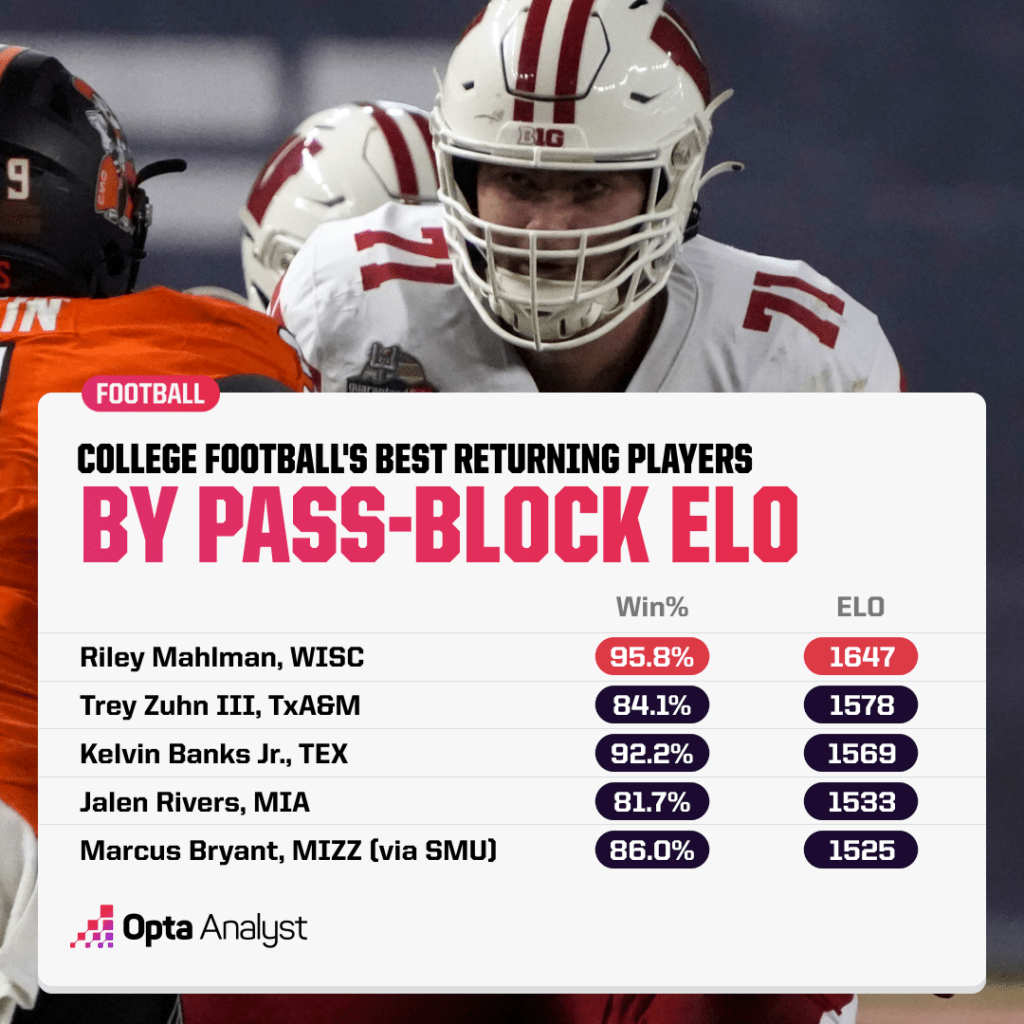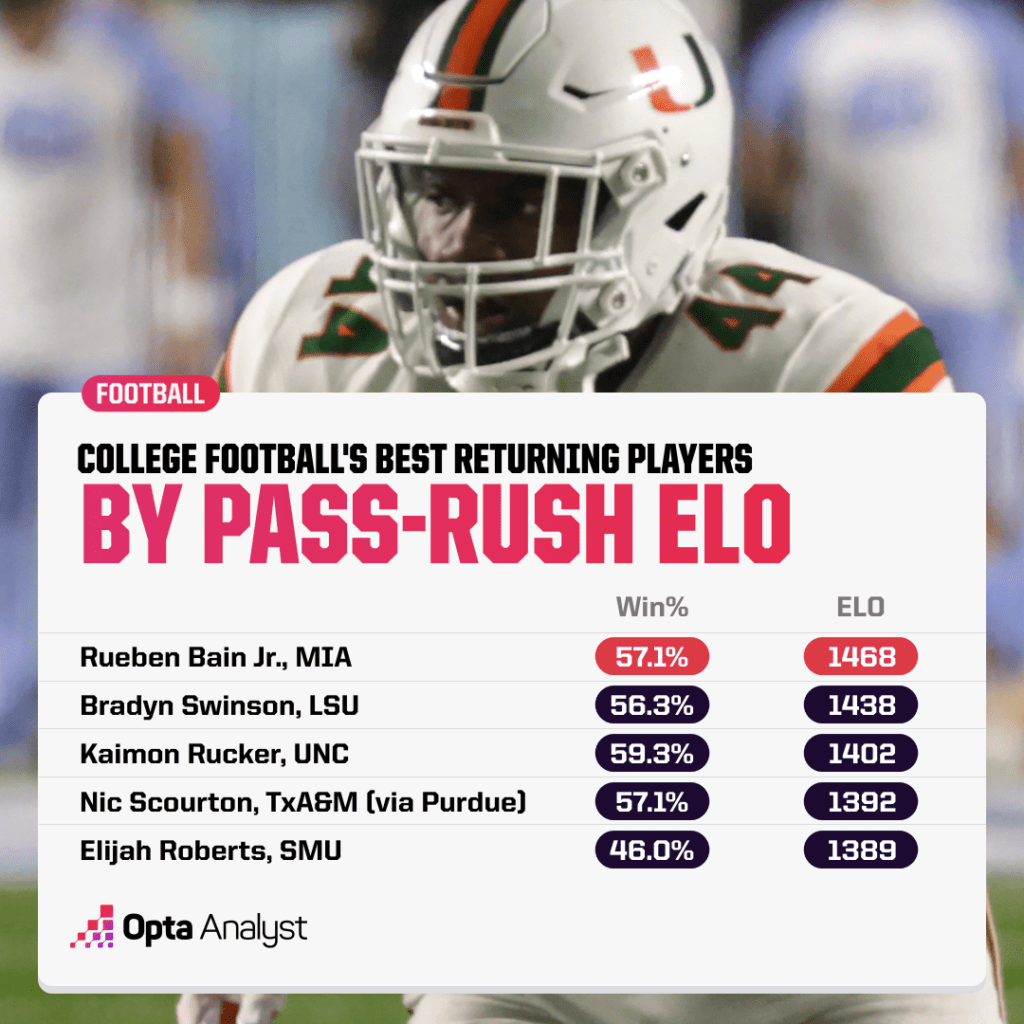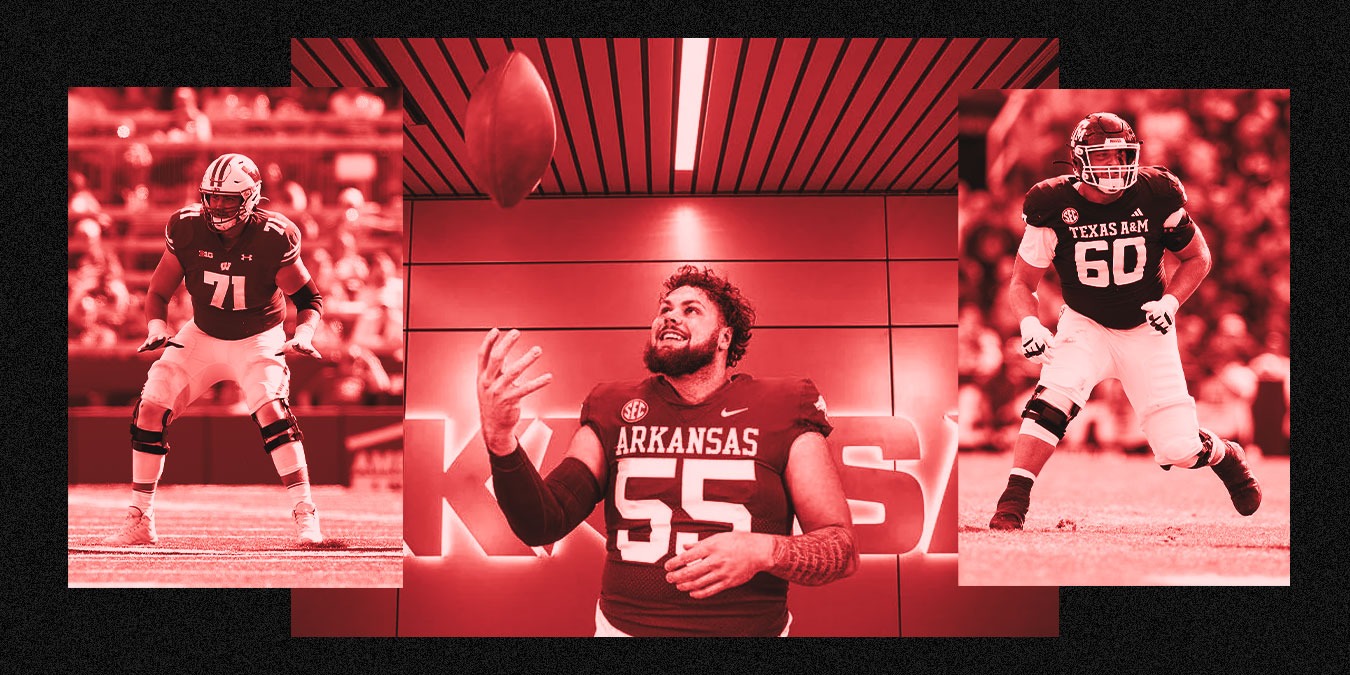We’re using our college football ELO ratings, which offer a deeper understanding of both pass protection and pass rushing than traditional sack numbers, to compare linemen on an even playing field by taking into account both position and quality of competition.
College football’s best teams are replacing loads of trench talent for 2024.
All five offensive linemen who made the Associated Press’s All-American First Team are now gone to the NFL, as are all four defensive linemen and edge defenders. As long as football remains about blocking and tackling, the big men will be the building blocks of conference and national contenders.
And ahead of the new season, there’s a vacuum at the top as teams try to establish dominance over the line of scrimmage. But our play-tracking data might help us figure out who will emerge as this season’s most dominant maulers.
Enter our college football ELO ratings, which offer a deeper understanding of both pass protection and pass rushing than traditional sack numbers. While looking through thousands of plays from the 2023 season, we charted win rates for defenders and blockers – and then adjusted them for both position and quality of competition.
Tackles have more challenging pass-blocking assignments than guards, and an edge rusher in the Big Ten has to beat better tackles than one in the Mountain West.
ELO can account for the difference and contextualizes players. In that spirit, let’s meet three offensive linemen and three defenders worth following closely this season.

Riley Mahlman, Right Tackle (Wisconsin)
Mahlman’s ELO rating isn’t just the best among returning offensive linemen but among offensive linemen who played in 2023, period. On 72 tracked 1-on-1 matchups, Mahlman posted a 95.8% win rate – the best of any tracked player.
He did this as a tackle playing in the Big Ten, where Wisconsin’s schedule included the defenses of Iowa, Ohio State and a saltier-than-some-realized Nebraska. So it’s not a surprise, with those dominant results playing that position in that league, that ELO rates Mahlman highly.
It didn’t translate to much for the Badger offense, which never got it together under first-year coordinator Phil Longo. A nagging injury to star tailback Braelon Allen did not help matters either. But having Mahlman makes it a much better bet that the Badgers will get things together in Longo’s second year running the show.
A new QB, in the form of Miami transfer Tyler Van Dyke to replace the ineffective Tanner Mordecai and Braedyn Locke (now set to back up Van Dyke instead of Mordecai), will hopefully ensure that Mahlman’s elite protection does not go totally to waste. Bucky’s success always begins on the lines.
Trey Zuhn III, Left Tackle (Texas A&M)
ELO respects Zuhn’s brutal competition level in the SEC West, as it grades him as the second-best returning lineman despite an otherwise unspectacular 84.1% win rate.
Zuhn has been a consistent starter for the Aggies for two years, and with a 2021 redshirt year under his belt, he’s got a nice mix of experience and eligibility still in front of him. Hanging onto Zuhn after firing Jimbo Fisher (and paying a $77 million buyout, in case anyone ever forgets that part) was a mega-win for A&M and the new staff under head coach Mike Elko.
Aggie quarterback Conner Weigman is one of the country’s most interesting breakout candidates this year, after injuries robbed him of that chance in 2023. But it will only happen if the program keeps the QB upright and reasonably healthy, and in that way, Zuhn is more important than anyone.
Fernando Carmona, Left Tackle (Arkansas)
Carmona was excellent last season, but he was excellent in the Mountain West. Arkansas hopes that the San Jose State transfer can be something similar in the SEC.
At SJSU, Carmona was an all-conference honorable mention but really stood out for his constant denial of pressures. He ranked 17th among all offensive tackles with at least 100 pass-protection plays with a 4.2 pressure-allowed rate. He also had a 93.3% win rate (and just two sacks allowed over the entire season) that was sixth among all tracked offensive lineman, but Carmona was a mere 161st in ELO because of the Spartans’ comparatively weak competition.
That’s still plenty good enough to be a transfer portal pickup at a place like Arkansas, which had a bad line last year and is searching for answers that might prevent coach Sam Pittman from getting fired. The return of once-disgraced head coach Bobby Petrino as offensive coordinator is one effort to find those answers, but Carmona is another.
Any path Arkansas has to fielding a decent offense this year involves Carmona translating from SJSU to the SEC.

Rueben Bain Jr., Edge Rusher (Miami)
Bain was a true freshman sensation for the Hurricanes, a real bright spot in a mostly disappointing second season under Mario Cristobal. Fresh out of high school, Bain was a starter by the third game of the season and became a consensus freshman all-American and the ACC’s Defensive Rookie of the Year.
His surface-level stats (7.5 sacks, 12.5 tackles for loss) were nice and he ranked seventh among edge rushers with at least 100 pass rushes with an 8.6 adjusted sack rate, but Bain was even more dominant than that. With a 57.1% pass-rush win rate on 70 tracked reps against high-level competition, Bain had the third-highest pass-rushing ELO in college football – behind only Michigan’s Jaylen Harrell and UCLA’s Laiatu Latu. Among returning players, Bain is comfortably in first place.
The sky is the limit here. Players in their first year in college football average a 37.0% pass rush win rate, just a bit more than half of what Bain posted as a true freshman. (And remember, most true freshmen barely see the field as defensive front players, given the strength demands of the position group).
Bain has every chance to earn multiple accolades and become an early NFL pick in 2026.
Elijah Roberts, Edge Rusher (SMU)
Roberts posted a 46.0% win rate for SMU, which was good enough in the context of his position and quality competition to make him 11th in pass rush ELO.
Roberts made that count for 10 sacks, and he also made himself one of the transfer portal’s biggest success stories of the year. (He’d spent three years as a rotational player at Miami and, ironically, was poised to be stuck behind Bain on the depth chart in Coral Gables.) With SMU, Roberts became a disruptive force, ranking 16th among edge rushers with a 24.5 pressure rate.
He’s a fascinating evaluation case for 2024, because SMU is moving from the American Athletic to the more challenging ACC. Roberts didn’t register a sack in three games against power conference competition last year, and he couldn’t crack the lineup the last time he played for an ACC program.
But if his 2023 emergence holds up, he’ll give SMU a competitive shot on defense in its debut ACC season.
Alfred Collins, Defensive Tackle (Texas)
Collins was one of the better defensive tackles in the country last year and also… a backup. Such is life when you play for Texas at the same time as one of the best tackle duos in recent memory – Byron Murphy and T’Vondre Sweat.
Murphy and Sweat were game-wreckers who keyed the Longhorns’ run to the College Football Playoff, but Collins, in his fourth year in the program, was quietly very good himself.
The backup posted a 40.0% pass-rush win rate – fourth in FBS among defensive tackles. (Murphy, one of the two men ahead of him on the depth chart, was first.) Murphy posted a top-25 ELO as a pass rusher and was a trusty run defender, deemed good enough by Steve Sarkisian and company to start six of the Horns’ 14 games even with Murphy and Sweat healthy enough to play for the entire season.
With those two gone, it’s probably inevitable that Texas seems some drop-off in the middle of the defensive line. But having a fill-in like Collins is an unusual luxury – even for a blue-blood program.
Stats Perform’s Kyle Cunningham-Rhoads contributed. Check out our MLB, NBA and NFL coverage. Follow us on X and Instagram for more!
